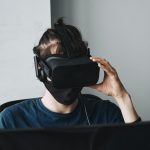There is a rise in demand for use of Virtual Reality in terms of soft skills training in the workspace for on-boarding, training and up-skilling employees.
Whether training is conducted in training rooms or remotely, following good sanitisation methods leads an organisation to set its mark in the industry as a valuable asset.With the speed that VR training offers, an organisation can get through multiple training sessions in a day. This comes with challenges on how to practice good hygiene in order to keep everybody safe and secure while also maintaining high standards of cleanliness for the workspace. In this article we will look at some easy practices to use in order to have clean VR headsets and training spaces.

How to practice Safe VR Training
VR training is a fun learning experience. It is also a very social one. Everyone indulged in this experience has a social responsibility to care for themselves as well as the equipment’s. Here are some ways to practice hygienic VR training procedures in your workplace-
Use Disposable VR Face Covers
One time use VR face pads are to be worn by the user before putting on a VR headset. The headsets face pads are the most used parts of the headsets and come in contact with everybody. Makeup residues, facial oils or sweats etc. can be kept at bay and you can have a safe and refreshed experience in your training by using a clean disposable VR face mask.
Silicone Covers for the win
Different from the disposable face covers, silicone covers are high Quality medical grade covers for your headsets which are a good investment as they protect against germs and unwanted dirt in the headset.
Washing hands and following good hand hygiene
Following good hand hygiene before using your VR tools is good in the short and long run. Your organization can also install a disinfectant dispenser near the VR training area in order to encourage good hand hygiene.
Washing Face, yes you heard that right!
Along with using face covers for VR, it is also beneficial to wash your face before and after using VR headsets. This is good for personal reasons such as leading to good skin, as bacteria from headsets can cause acne if you have sensitive skin. as well as for having longer lasting clean VR headsets.
Diligently cleaning VR headsets after each use
VR headsets have detachable parts like face pads and head straps, these can be frequently washed as they come in contact with a lot of people in training scenarios. Other parts of the headsets can be disinfected by non-abrasive disinfectant sprays or wipes. A word of caution for trainees and facilitators indulged in cleaning is only to clean the lenses of the VR headsets with microfiber cloth as it is very sensitive and can be damaged easily otherwise.
UVC Disinfectant device
This option is a bit on the pricey side but is one of the most efficient one in order to clean the headsets. A UV-C device uses medical quality ultraviolet C rays in order to kill off germs on the surface of the VR headset. This paves way to a cleaner and quicker practice of cleaning headsets in an extensive training environment.
Train your Facilitator
Training your training facilitators can be useful in order for them to implement better hygiene rules and make the training environment welcome and safe for the organization.
The rise of VR Training and Safety
Organizations are on top of their game by upskilling employees with VR training during a time when remote work is significantly increasing. VR training is leading the way in the industry hence it is important to still keep high safety standards as a top priority.
There are simulations in VR training that are related to practicing better hand hygiene, for example by Tork, a leading company in global hygiene and health which trains healthcare workers through its program called ‘Clean Hands Training and Education.’
The importance of a hygienic workplace is a health priority and a chance for your institute to set an example for time to come.
Written by Simran Singh







